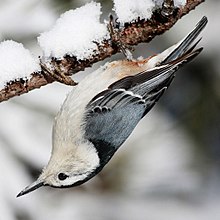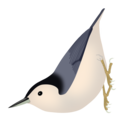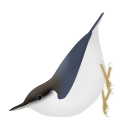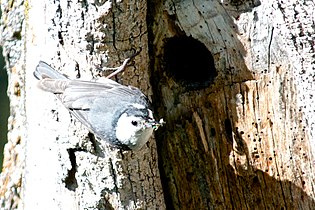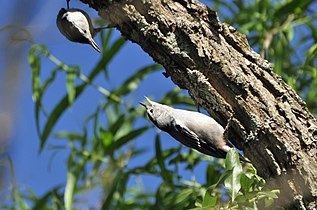
The nuthatches constitute a genus, Sitta, of small passerine birds belonging to the family Sittidae. Characterised by large heads, short tails, and powerful bills and feet, nuthatches advertise their territory using loud, simple songs. Most species exhibit grey or bluish upperparts and a black eye stripe.

The Eurasian nuthatch or wood nuthatch is a small passerine bird found throughout the Palearctic and in Europe. Like other nuthatches, it is a short-tailed bird with a long bill, blue-gray upperparts and a black eye-stripe. It is a vocal bird with a repeated loud dwip call. There are more than 20 subspecies in three main groups; birds in the west of the range have orange-buff underparts and a white throat, those in Russia have whitish underparts, and those in the east have a similar appearance to European birds, but lack the white throat.
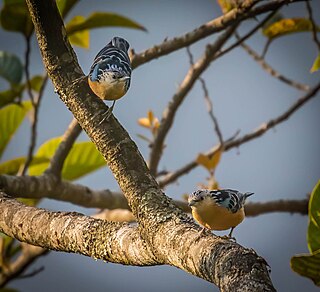
The beautiful nuthatch is a bird species in the family Sittidae, collectively known as nuthatches. It is a large nuthatch, measuring 16.5 cm (6.5 in) in length, that is not sexually dimorphic. Its coloration and markings are dramatic, the upper parts being black and azure, streaked with white and pale blue on the head and lined with the same colors on the wing feathers. The underparts are orange, and the eyebrow and throat are ochre. An irregular, dark eyestripe highlights its eye. S. formosa's ecology is not fully described, but it is known to feed on small insects and larvae found on the trunks and epiphyte-covered branches of trees in its range. Reproduction takes place from April to May; the nest is placed in the hole of an oak, rhododendron, or other large tree. The nest is made of plant material and fur in which the bird typically lays four to six eggs.

The red-breasted nuthatch is a small songbird. The adult has blue-grey upperparts with cinnamon underparts, a white throat and face with a black stripe through the eyes, a straight grey bill and a black crown. Its call, which has been likened to a tin trumpet, is high-pitched and nasal. It breeds in coniferous forests across Canada, Alaska and the northeastern and western United States. Though often a permanent resident, it regularly irrupts further south if its food supply fails. There are records of vagrants occurring as far south as the Gulf Coast and northern Mexico. It forages on the trunks and large branches of trees, often descending head first, sometimes catching insects in flight. It eats mainly insects and seeds, especially from conifers. It excavates its nest in dead wood, often close to the ground, smearing the entrance with pitch.

The velvet-fronted nuthatch is a small passerine bird in the nuthatch family Sittidae found in southern Asia from Nepal, India, Sri Lanka and Bangladesh east to south China and Indonesia. Like other nuthatches, it feeds on insects in the bark of trees, foraging on the trunks and branches and their strongly clawed toes allow them to climb down tree trunks or move on the undersides of horizontal branches. They are found in forests with good tree cover and are often found along with other species in mixed-species foraging flocks. Adult males can be told apart by the black stripe that runs behind and above the eyes. They have a rapid chipping call note. They breed in tree cavities and holes, often created by woodpeckers or barbets.

The Corsican nuthatch is a species of bird in the nuthatch family Sittidae. It is a relatively small nuthatch, measuring about 12 cm (4.7 in) in overall length. The upperparts are bluish gray, the underparts grayish white. The male is distinguished from the female by its entirely black crown. The species is sedentary, territorial and not very shy. It often feeds high in Corsican pines, consuming mainly pine nuts, but also catching some flying insects. The breeding season takes place between April and May; the nest is placed in the trunk of an old pine, and the clutch has five to six eggs. The young fledge 22 to 24 days after hatching.

The Algerian nuthatch or Kabyle nuthatch, is a species of bird in the nuthatch family Sittidae. It is a medium-sized nuthatch, measuring between 11.5 cm (4.5 in) and 12.5 cm (4.9 in). The upperparts are bluish gray. The male can be distinguished from the female by the black front of its crown. The species is sedentary; it feeds on arthropods in summer and on seeds in winter. The breeding season takes place around May–June. The nest, built in a hole of tree, shelters a laying of three or four eggs, brooded by the female. The chicks are fed by both parents.

The western rock nuthatch is a small passerine bird which breeds from Croatia east through Greece and Turkey to Iran. This nuthatch is largely resident apart from some post-breeding dispersal. The eastern rock nuthatch Sitta tephronota is a separate species, which occurs further east in south-central Asia.

The pygmy nuthatch is a tiny songbird, about 10 cm (4 in) long and about 10 grams in weight.

The brown-headed nuthatch is a small songbird endemic to pine forests throughout the Southeastern United States. Genetic analyses indicated low differentiation between northern and southern populations in Florida, but the study also found lower genetic diversity among south Florida populations that may be a result of the increased habitat fragmentation that was documented. The Bahama nuthatch was formerly considered a subspecies (S. p. insularis), has since been reclassified as its own separate species. Two recent studies assessing vocalizations in Bahama and continental nuthatch populations found important differences. One of the studies also demonstrated that continental and Bahama populations did not respond aggressively to calls of the other population. This type of call-response study is often used to help define cryptic species.

Krüper's nuthatch is a species of bird in the family Sittidae. It is a small to medium-sized nuthatch, measuring 12.5 centimetres (4.9 in) in length. The upperparts are blue-gray, with the front half of the crown black in adults of both sexes, but with a less marked in the female rear. The species has a black or gray eyestripe and a prominent white supercilium. The underparts are blue-gray in males and buff-gray in females, with a large, crescent-shaped rufous pectoral patch. The Krüper's nuthatch feeds on insects in the summer and seeds, especially pines, in the fall and winter. Breeding takes place between March and May, and the nest is usually placed in a tree hole. The clutch consists of five to seven eggs, incubated by the female and fed by the male. Both parents take part in feeding the young.

The blue nuthatch is a bird species in the nuthatch family Sittidae. It is a medium-sized nuthatch, measuring 13.5 cm (5.3 in) in length. The species, which shows slight sexual dimorphism, has dramatic coloration unlike any other member of its genus. Its head is black or blackish-blue dark blue upperparts close to purple with azure feathers. The wings are edged with black. The throat and chest are white or a washed buff color, contrasting with the upperparts and the belly of a very dark blue; the covert feathers are generally clear, blue-gray or purplish.
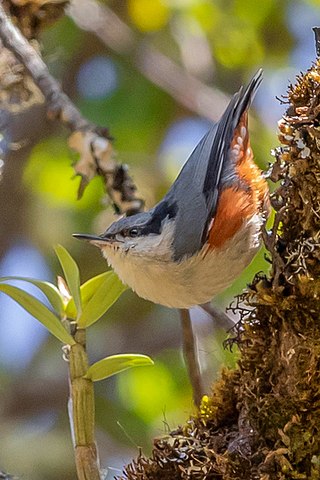
The chestnut-vented nuthatch is a species of bird in the nuthatch family Sittidae. It is a medium-sized nuthatch, measuring 12.5–14 cm (4.9–5.5 in) in length. The upperparts are a solid gray blue, with a markedly black loral stripe. The underparts are uniform gray to buff from the throat to belly, with brick red on the flanks. The undertail is white with a rufous border. The chestnut-vented nuthatch utters different kinds of calls, which can sometimes sound like a troglodyte alarm, and its song is a monotonous, stereotypical crackle, typically chichichichi. Its ecology is poorly known, but it probably feeds on small arthropods and seeds, and the breeding season begins between March and May. The nest is typically located in a hole in the trunk of a tree, and the clutch has two to five eggs.

The white-browed nuthatch, also known as the Victoria nuthatch, is a species of bird in the family Sittidae. It is a small nuthatch, measuring 11.5 cm (4.5 in) in length and without sexual dimorphism. Like many other nuthatches, the upperparts are gray-blue, contrasting with white underparts on the throat, cheeks, and breast and orange on the flanks, belly, and lower abdomen. Its white supercilium makes it easy to distinguish it from the white-tailed nuthatch, which is a close species in the systematic and geographical sense. Little is known about its ecology, but it feeds on small insects found among bark and lichens, and breeding occurs around April.

The Chinese nuthatch or snowy-browed nuthatch is a species of bird in the family Sittidae. It is a small nuthatch, measuring 11.5 cm (4.5 in) in length. The upperparts are blue-gray and the underparts from a dull buff-grayish to a cinnamon-orange; the cheeks are white. There is a marked sexual dimorphism: the adult male is distinguished by its very black crown, while that of the female is the same blue-grey as the back, or at most dark gray when the plumage is worn. In both sexes, a dark gray eyestripe extends in front of and behind the eye, topped by a clear white supercilium separating it from the crown. The song is variable, and composed of repetitions of small invariant whistles. The species feeds mainly on insects in summer and completes its diet with seeds and fruits. The nest is generally placed in the hole of a conifer. The pairs raises one brood per year, with five or six chicks.

The Yunnan nuthatch is a bird species in the nuthatch family Sittidae. It was first described by William Robert Ogilvie-Grant in 1900 based on a male holotype. It is a small nuthatch, measuring 12 centimetres (4.7 in) in length on average and weighs between 7.5 and 13 grams. The grey-blue upperparts contrast with the light, smooth, buffy lowerparts. It has a fine white eyebrow above a black eyestripe, which is distinct when the plumage is fresh, and exhibits a small degree of sexual dimorphism. A noisy bird, it produces simple, nasal sounds, sometimes in repetitive series.

The Siberian nuthatch is a bird species of the family Sittidae. For a long time considered as a subspecies of the Eurasian nuthatch, it was clearly differentiated in 2006 on the basis of morphological and molecular characters. It is on average larger than the Eurasian nuthatch and also differs in some morphological features such as the shape of its bill, the size of its claws and the color of its underwing and outer rectrices. Its song has also been described as "distinctly different" from that of the Eurasian nuthatch, though without further clarification.

Przevalski's nuthatch, originally given the nomen nudumSitta eckloni, is a bird species in the family Sittidae, collectively known as nuthatches. Long regarded as a subspecies of the white-cheeked nuthatch, it nevertheless differs significantly in morphology and vocalizations. Both S. przewalskii and S. leucopsis have been regarded as closely related to the North American white-breasted nuthatch. It is a medium-sized nuthatch, measuring about 13 cm (5 in) in length. Its upper body is a dark gray-blue or slate color, becoming dark blue-black at the crown. The cheeks and throat are a white buff-orange, turning to a rich cinnamon on the underparts that intensifies in color on the sides of the breast. Vocalizations consist of alternating series of ascending whistles and short notes.

The giant nuthatch is a species of bird in the family Sittidae. It is the largest of the nuthatches, measuring 19.5 cm (7.7 in) in length. Its upperparts are bluish gray, with the front being light gray, contrasting with the darker rest of the back. The bird has two very thick black eyebrow lines and light gray underparts, with whitish cheeks and throat, and a belly more or less washed with buff and cinnamon. For a nuthatch, it has a long beak and tail. The female can be distinguished from the male by its duller eye features and its upperparts having less contrast between the crown, nape, and lower back. The calls are powerful and made up of repetitions of simple patterns. The species gleans its food from the trunks and branches of trees, especially pines, and feeds on insects and berries. It nests around March, in the hole of a tree and without masking the entrance, and the nest has about three young.



